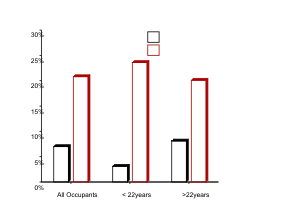















Traffic Tech #93: Primary Enforcement of Seat Belt Use Laws Saves Lives and Reduces Injuries |
|---|
|

Number 93 May 1995
PRIMARY ENFORCEMENT OF SEAT BELT USE LAWS SAVES LIVES AND REDUCES INJURIES
Highway fatalities and injuries have been declining over the past decade. One major reason is that more motorists are wearing their seat belts. Most states (48) in the US now have mandatory seat belt use laws to encourage motorists to buckle up, or face the possibility of getting a citation. The National Highway Traffic Safety Administration (NHTSA) reports on the effectiveness of these mandatory seat belt laws in increasing seat belt usage and reducing crash fatalities.
Primary and Secondary Laws
As of September 1994, nine of the 48 states allow primary enforcement and 39 states and the District of Columbia allow secondary enforcement of seat belt laws. Primary enforcement means that law enforcement officers may issue a citation any time they observe an unbelted driver or passenger. Secondary enforcement means that officers may issue a safety belt citation if and only if the officer has stopped the vehicle for some other reason.
States with primary laws have significantly higher safety belt use rates and greater reductions in fatality and injury rates, as compared to states with secondary laws. California's recent change from secondary to primary enforcement provides strong evidence of the benefits of enacting primary enforcement seat belt use laws.
Higher Belt Use Rates in Primary Law States
Seat belt usage rates in the nine primary law states averaged 12 percentage points higher than in the secondary law states (75 versus 63 percent) as of December 1993. Drivers in California increased their belt use from 70 percent in 1992 when they had a secondary enforcement law to 83 percent in late 1993 after the state changed to primary enforcement. A NHTSA study showed that driver belt use increased nearly 18 percentage points in six California cities in the first few months of the primary law. This increase was almost identical to the jump that occurred in the same cities when the secondary enforcement law was first adopted in 1986. Similar findings from The Insurance Institute for Highway Safety report that Los Angeles drivers and front seat passengers increased their usage from 56 to 76 percent. Sacramento, San Francisco, and San Diego showed similar impressive gains.

Percent Reduction in Fatality Rate
Greater Fatality Reduction
During the first full year after enforcement of belt laws, fatality rates dropped 21 percent in five primary states compared to only 7 percent in 11 secondary law states. During the same period there was a 24 percent reduction in fatality rates for persons under 21 years old in the primary states compared to a 3 percent reduction for that age group in the secondary law states.
North Carolina has had a primary enforcement law since 1985. In 1993 and 1994, North Carolina launched Click It Or Ticket, a joint public awareness and enforcement campaign to increase seat belt usage in the state. While seat belt usage dramatically increased from 63 to 81 percent, state officials claim the program saved 45 lives, prevented 320 disabling injuries, and saved North Carolinians more than $51 million in health care and other costs in the first six months or the program alone. Under North Carolina law, the $25 fine for not buckling up goes to local schools. Click It Or Ticket has provided more than $1 million to local school districts.
Public Opinion
Primary enforcement laws send motorists a clear message that the state considers belt use mandatory for the safe operation of a motor vehicle. In a public opinion survey in Michigan in 1988, 68 percent reported that their belt use would increase if the police could pull them over just for not using their seat belt. California's experience with the upgrade to primary enforcement shows no significant adverse public or official reaction. Similar support was found in telephone surveys in North Carolina. After a statewide publicity and enforcement effort announced the new law, a phone survey revealed that 85 percent were aware of the effort and 87 percent supported it.
Surveys of public approval suggest that while a substantial proportion of the population do not always support primary laws prior to enactment, the majority support them after passage. In a national phone survey in 1991, 73 percent said they would support primary seat belt legislation in their state if they knew it would result in more safety belt use and more lives saved.
Law Enforcement Attitude Surveys
Officers consistently prefer primary laws. They report that a secondary enforcement law is a deterrent to them in issuing citations. In a 1986 Michigan State University study, patrol officers and police administrators said that primary enforcement would lead to a higher priority being given to belt law enforcement.
Traffic and patrol officers in each of the six California cities NHTSA studied favored the change to primary enforcement. Most officers felt that it communicated to motorists both the need for using belts and the possibility that an enforcement action might be taken.
Recommendations
The NHTSA report includes recommendations made by various groups, organizations, and policy advisors who studied the effectiveness of belt laws, including the US General Accounting Office, the National Research Council, and the National Committee for Injury Prevention and Control.
For a copy of the 15 page report, The Case for Primary Enforcement of Seat Belt Use Laws, contact the Office of Occupant Protection, NHTSA, NTS-12, 400 Seventh Street, S.W. Washington, DC 20590, or send a fax to (202) 493-2062.
U.S. Department of Transportation
National Highway
Traffic Safety
Administration
400 Seventh Street, S.W. NTS-33
Washington, DC 20590
Traffic Tech is a publication to disseminate information about traffic safety programs, including evaluations, innovative programs, and new publications. Feel free to copy it as you wish.
If you would like to receive a copy contact:
Linda Cosgrove, Ph.D., Editor,
Evaluation Staff Traffic Safety Programs
(202) 366-2759
